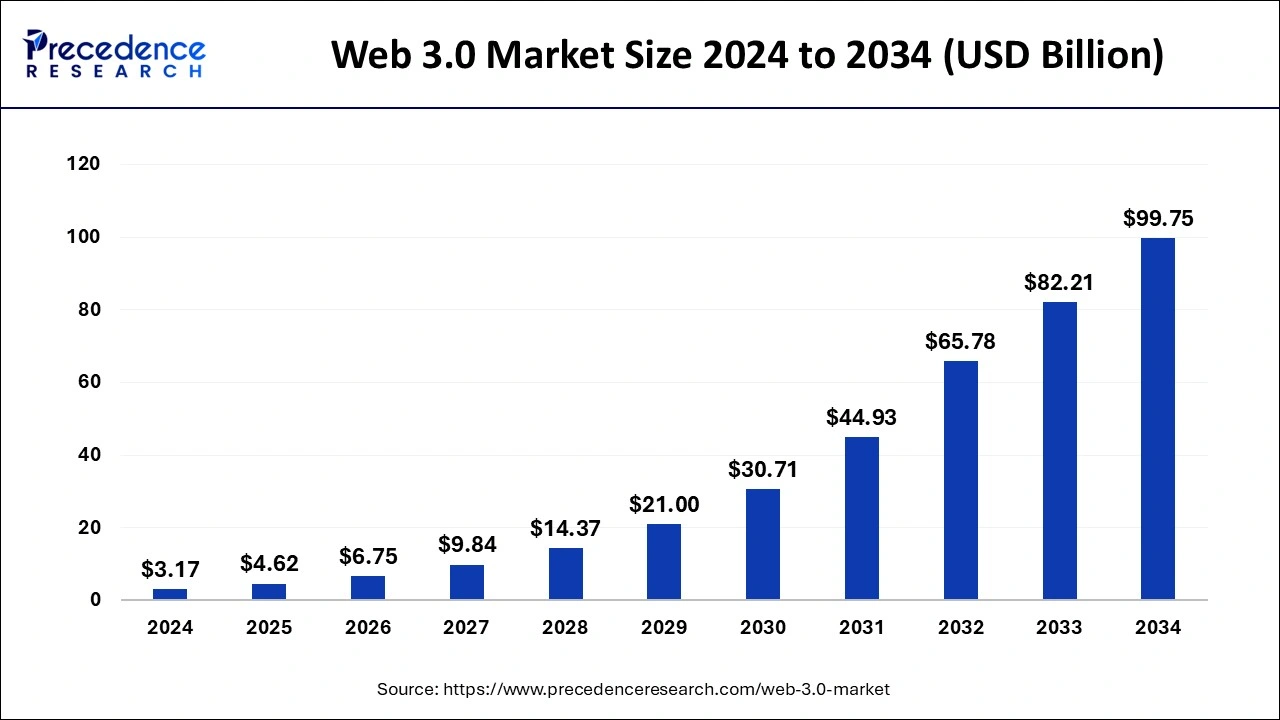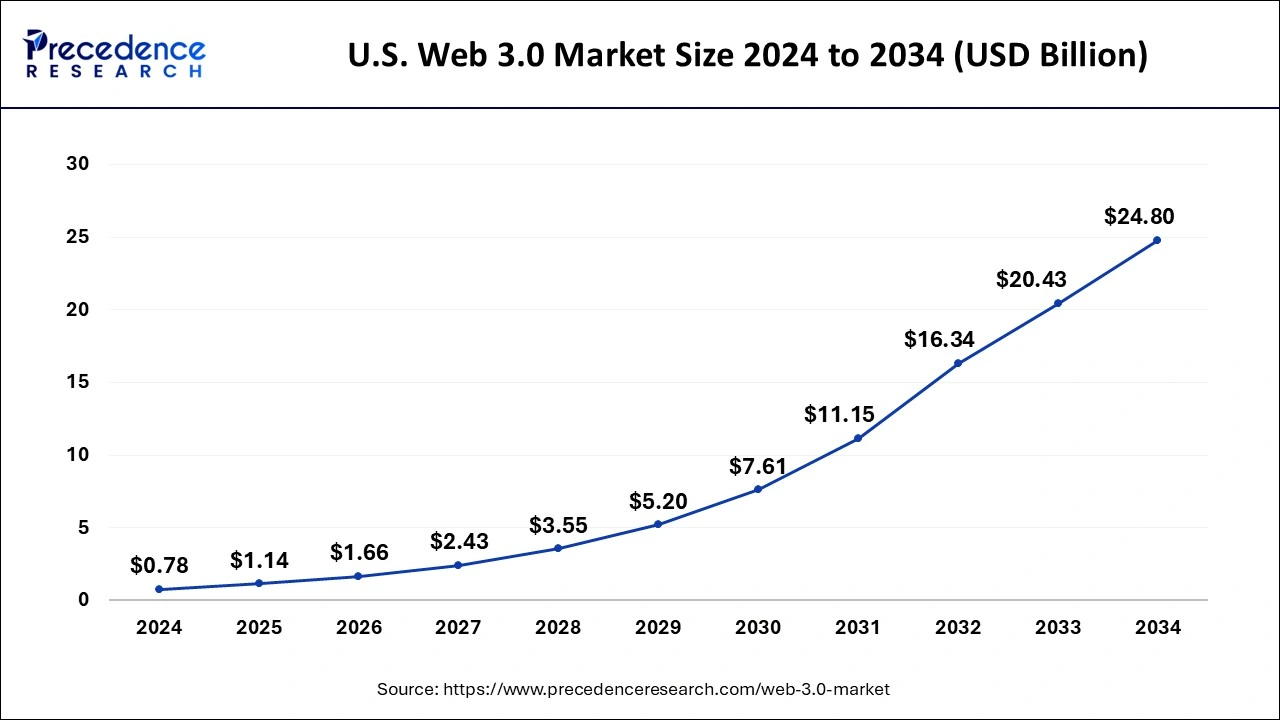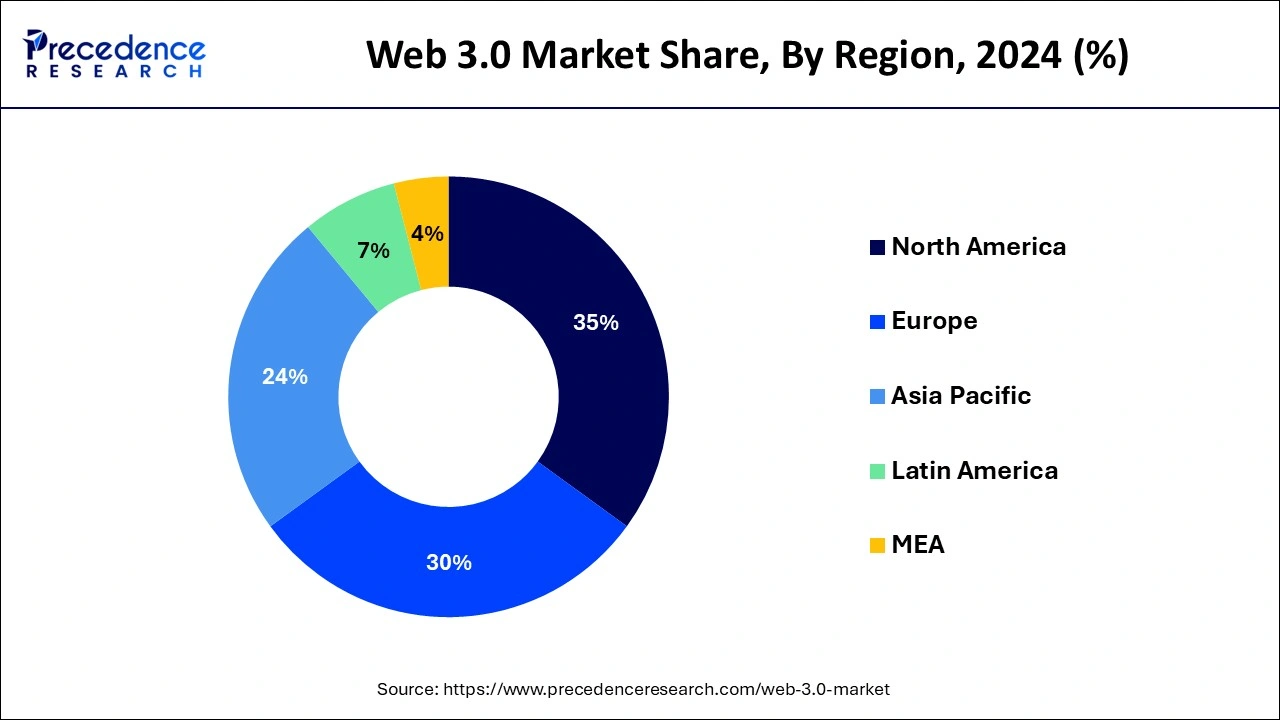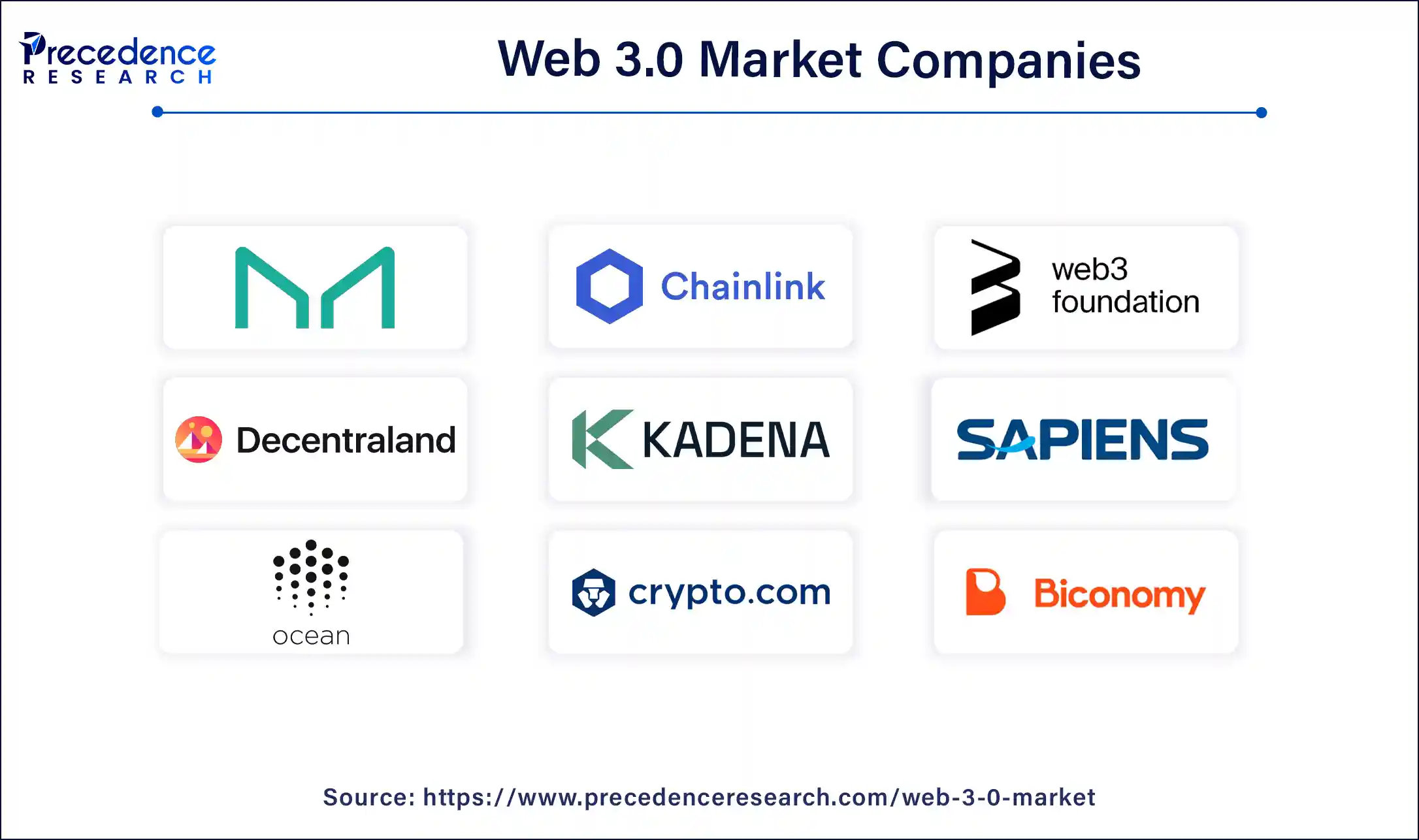The global web 3.0 market size is calculated at USD 4.62 billion in 2025 and is forecasted to reach around USD 99.75 billion by 2034, accelerating at a CAGR of 41.18% from 2025 to 2034. The North America web 3.0 market size surpassed USD 1.11 billion in 2024 and is expanding at a CAGR of 41.20% during the forecast period. The market sizing and forecasts are revenue-based (USD Million/Billion), with 2024 as the base year.
The global web 3.0 market size was estimated at USD 3.17 billion in 2024 and is anticipated to reach around USD 99.75 billion by 2034, expanding at a CAGR of 41.18% from 2025 to 2034. The web 3.0 market is driven by the metaverse's ascent. A virtual environment called the metaverse allows users to communicate with digital items and one another. With web 3.0 technology at its core, it is frequently regarded as the next evolution of the internet. The metaverse may transform the way we work, learn, and play.

Web 3.0 is the next phase of the evolution of the internet, promising to bring more user privacy, openness, and empowerment. In the web 3.0 industry, AI is emerging as a major fundamental building blocks, promising to enhance the user experience via improved human-machine interactions and better content recommendations. AI-generated recommendation engines are being equipped in popular Web 3.0 applications such as Netflix and Amazon, with more advanced real-world utility as blockchain developers integrate machine learning and AI technologies. While AI algorithms will continuously adapt to each individual’s preferences, Web 3.0 users will receive more relevant ads. In addition, the integration of AI helps in various technological content such as increased content safety, more relevant advertising, and smarter dApps and intelligent NFTs. These advanced trends are expected to transform the growth of the Web 3.0 market in the coming years.
The U.S. web 3.0 market size was evaluated at USD 0.78 billion in 2024 and is predicted to be worth around USD 24.80 billion by 2034, rising at a CAGR of 41.33% from 2025 to 2034.

North America dominated the global market with the largest market share of 35% in 2024 and is expected to sustain dominance throughout the predicted timeframe. North America is known for being a global center of technical innovation, especially Silicon Valley in California. Historically, this area has led the way in developing innovative technologies. It focuses on top businesses and startups developing Web 3.0 technologies, including smart contracts, decentralized applications (DApps), and blockchain. Its populace is tech-savvy and sizable, and they are typically more open to embracing new technologies.

The need for decentralized and more secure alternatives to existing web services may propel the creation and uptake of web 3.0 applications. The North American collaborative ecosystem, where businesses frequently cooperate and exchange expertise, can expedite web 3.0 technology development and integration. This spirit of cooperation can strengthen the area's dominance through a network effect.
The subsequent phase of the Internet's evolution, web 3.0, is defined by decentralized, intelligent, and networked systems to deliver a safer and more user-friendly online experience. Cutting-edge technologies like artificial intelligence (AI), decentralized applications (DApps), and blockchain are essential to changing the digital landscape in the web 3.0 market. Web 3.0, in contrast to its predecessors, strongly emphasizes user control over data, privacy, and cross-platform compatibility.
The web 3.0 market includes various services and applications, such as smart contracts, decentralized identity management, non-fungible tokens (NFTs), and decentralized finance (DeFi). By addressing the shortcomings of Web 2.0, these developments hope to promote equality, openness, and trust in the digital economy.
Considerable shifts in several industries are expected as the web 3.0 industry develops further. For instance, web 3.0's decentralized architecture can make banking industry transactions more secure and efficient. It can make patient data sharing safe and more accessible in the healthcare industry, resulting in better care coordination. A new era of creativity and cooperation on the Internet is anticipated to be ushered in by the empowerment of individuals through greater control of their digital assets and interactions, affecting not just these areas but many more.
| Report Coverage | Details |
| Growth Rate from 2025 to 2034 | CAGR of 41.18% |
| Market Size in 2025 | USD 4.62 Billion |
| Market Size by 2034 | USD 99.75 Billion |
| Largest Market | North America |
| Base Year | 2024 |
| Forecast Period | 2025 to 2034 |
| Segments Covered | By Technology Stack, By Infrastructure Layer, By Protocol Layer, By Utility Layer, By Service Layer, and By Application Layer |
| Regions Covered | North America, Europe, Asia-Pacific, Latin America, and Middle East & Africa |
Increasing adoption of blockchain technology
In the web 3.0 sector, one of the main drivers is the rising use of blockchain technology. The decentralized and secure characteristics of blockchain improve data integrity, transparency, and confidence in online interactions, laying the groundwork for the internet's future development. This technology promotes a more effective, safe, and networked digital world by enabling smart contracts, tokenization, and decentralized applications (DApps).
Evolution of the Internet of Things (IoT) and smart devices
The web 3.0 market is primarily shaped by the advancement of smart devices and the internet of things (IoT). These networked devices create a more intelligent and engaging online by enabling decentralized applications and smart contracts with the massive volumes of real-time data they generate. IoT and web 3.0 work together to improve security, efficiency, and user experiences, which propels the development of decentralized systems and the wider digital world.
Lack of awareness about Web 3.0 blockchain
The major market constraint that prevents web 3.0 blockchain from being widely adopted is a need for more awareness of it. Web 3.0's growth and possible effect on decentralized applications and services are hindered by the need for more awareness among many potential consumers and businesses regarding its features and benefits. To fully utilize web 3.0 technology, more needs to be done regarding education and awareness campaigns. The technological nuances of web 3.0 and blockchain concepts are complicated, making it difficult for the typical user to understand. Those who need to learn more about computer science or information technology may find it overwhelming to comprehend the decentralized nature, consensus processes, and cryptographic principles.
There may be a need for more readily available or restricted Web 3.0 and blockchain teaching resources. Due to a lack of thorough, easily navigable learning resources, many individuals may need to be aware of these technologies' possible advantages or applications. Businesses and initiatives operating in the web 3.0 arena need to better explain to the public the benefits of their products. Adoption and awareness might be hampered by insufficient marketing efforts or by concentrating on technical details without considering a larger audience.
Integration of Web 3.0 technology into existing businesses and industries
Using blockchain to create traceable and transparent supply chains helps prevent counterfeiting and guarantees authenticity. To promote a more equitable data economy, companies can set up data markets where users maintain control over their data and decide whether to share it with companies in return for benefits. Businesses may create cross-platform applications with Wasm, guaranteeing compatibility between various devices and platforms.
By facilitating communication and data exchange between blockchains, integration with interchain protocols contributes to developing a more interconnected and interoperable web. For applications like smart cities and industrial IoT, security, transparency, and data integrity are crucial, and using blockchain for IoT devices improves these aspects. By educating staff members on web 3.0 concepts and technology, companies can ensure they have the know-how to successfully negotiate the changing business environment.
The privacy & security protocol segment holds the dominating share of the market. The goal of web 3.0 is to give users more control over their data. Privacy and security procedures are essential to guarantee that users can monitor and restrict access to their personal information. User control and data ownership are prioritized, and decentralized identity solutions, cryptographic authentication, and self-sovereign identity systems are crucial. End-to-end encryption and privacy-aware communication methods are quickly becoming requirements for web 3.0 apps.
These technologies guarantee the privacy and security of user data and communications. Following security and privacy guidelines becomes crucial for regulatory compliance as privacy issues and data protection laws become increasingly prominent worldwide. Privacy-focused web 3.0 solutions will probably draw consumers and businesses to try to comply with regulations.
The decentralized autonomous organization (DAOs) segment is expected to dominate the web 3.0 market during the forecast period. Blockchain technology powers DAOs, allowing for decentralized decision-making. With voting power based on stake, participants can exercise democratic government without centralized authority. DAOs facilitate global involvement and inclusivity as they are available to everyone with an internet connection. Geographical constraints are removed by this decentralized structure, which promotes a multicultural and international community. Since DAOs use voting processes to make choices collectively, they can quickly adjust to changes. This flexibility encourages creativity and enables DAOs to react rapidly to changing market conditions and technological breakthroughs.
The BFSI segment is expected to dominate the web 3.0 market during the forecast period. Blockchain is an essential part of decentralized technologies often associated with web 3.0. The BFSI industry is very interested in blockchain technology because it promises to make financial transactions transparent and safe. The decentralized design of web 3.0 facilitates increased security and a reduction in the requirement for middlemen in transactions involving money.
Web 3.0 makes it possible to build smart contracts or self-executing agreements with the terms of the agreement written into code. This can simplify financial operations like settlements and automate tasks that formerly required human involvement. The decentralized and focused user architecture of Web 3.0 may lead to improved customer experiences in the BFSI sector. This encompasses the potential for customized financial services that meet needs and faster and more secure operations.

By Technology Stack
By Infrastructure Layer
By Protocol Layer
By Utility Layer
By Service Layer
By Application Layer
By Geography
For inquiries regarding discounts, bulk purchases, or customization requests, please contact us at sales@precedenceresearch.com
No cookie-cutter, only authentic analysis – take the 1st step to become a Precedence Research client